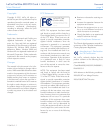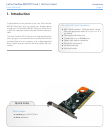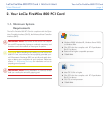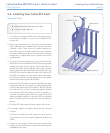
LaCie FireWire 800 PCI Card • DESIGN BY SISMO FireWire 800 Questions & Answers
User Manual page 10
What Does IEEE 1394 Mean?
IEEE (the Institute of Electrical and Electronics Engineers) refers to
the engineering corps that developed the 1394th standard, de-
fining the high-performance serial input/output (I/O) bus used to
connect peripheral devices. There are now two standards: IEEE
1394a, which refers to the original standard adopted in 1995,
and IEEE 1394b, which refers to the new standard, adopted in
2002.
What Is The Relationship Between IEEE 1394,
FireWire, iLink And DV?
These four names all refer to the same interface:
✦ IEEE 1394 is the term commonly used in the computer in-
dustry.
✦ FireWire is the brand name used by Apple.
✦ iLink is the brand name used by Sony for both consumer
electronics and personal computers.
✦ DV is short for “Digital Video,” and is used as the logo for
the interface on most video camcorders.
What Are The Benefits Of The FireWire Interfaces?
The FireWire interface is a fast, cross-platform serial bus, and is
ideal for digital audio, video and graphic applications that de-
mand plenty of bandwidth. Both versions of FireWire offer Plug &
Play connectivity, so all you have to do is plug in your drive and
begin using it, they also allow up to 63 devices to be connected
via a single bus and offer peer-to-peer connectivity, enabling
multiple computers and FireWire devices to be connected at the
same time. FireWire also supports both isochronous and asyn-
chronous capabilities, meaning that it can guarantee real-time
data delivery, so there is no danger of inaccurately ordered or
delayed frames.
What Is The Difference Between FireWire 400 And
FireWire 800?
Essentially, the main difference between the two interfaces can
be summed up in one word: speed. FireWire 800 effectively
doubles the bandwidth of the original FireWire 400 interface.
The new FireWire 800 interface offers truly impressive results,
with speeds up to 800Mb/s for a single bus, and even greater
for several buses in RAID0 configurations.
Other key advancements include the support of increased ca-
bling distances and a newly enhanced arbitration architecture.
Utilizing cables constructed of professional-grade glass optical
fiber, when both devices are connected via a FireWire 800 hub,
FireWire 800 can burst data across 100 meters of cable.
The new arbitration scheme greatly improves on the existing
architecture by incorporating advanced 8B10B data encoding
(based on codes used by Gigabit Ethernet and Fibre Channel),
which reduces signal distortion, and also improves the arbi-
tration time by prepping the arbitration while the current data
packet is being sent, so that data is sent as soon as the current
transmission is completed.
What Are The Ideal Uses For FireWire?
FireWire helped fuel a revolution for digital content creators,
and was awarded a 2001 Primetime Emmy Engineering Award
by the Academy of Television Arts & Sciences for its contribution.
Due to its high bandwidth and support of both isochronous and
asynchronous data delivery, FireWire has found a very successful
place in both the computer and consumer electronics industries.
Whether connecting game consoles, personal video recorders,
home stereo equipment, digital TVs, hard drives, CD/DVD-RW
drives, printers, scanners, tape drives or other digital hardware
equipment, FireWire is well-suited to handle all these various
requirements.
With the advent of the new FireWire 800 standard, the revolu-
tion created by the original will only grow. For those working
with digital video, the new standard will enable new bandwidth-
intensive applications, such as multiple-stream, uncompressed,
standard-definition video.
Will FireWire 400 Devices Run Faster When Con-
nected To A FireWire 800 Port?
Unfortunately, this is not the case. In order to attain FireWire
800 speeds, both the device and port have to be FireWire 800
enabled. For instance, an external hard drive with a FireWire
800 9-pin connection will only reach FireWire 800 transfer rates
when it is connected to a FireWire 800 9-pin host bus adapter
card via a properly certified FireWire 800 9-pin to 9-pin beta
cable.
When a FireWire 400 device is connected to a FireWire 800
port, the FireWire 400 device will only operate at the original
FireWire 400 speeds.
4. FireWire 800 Questions & Answers
















